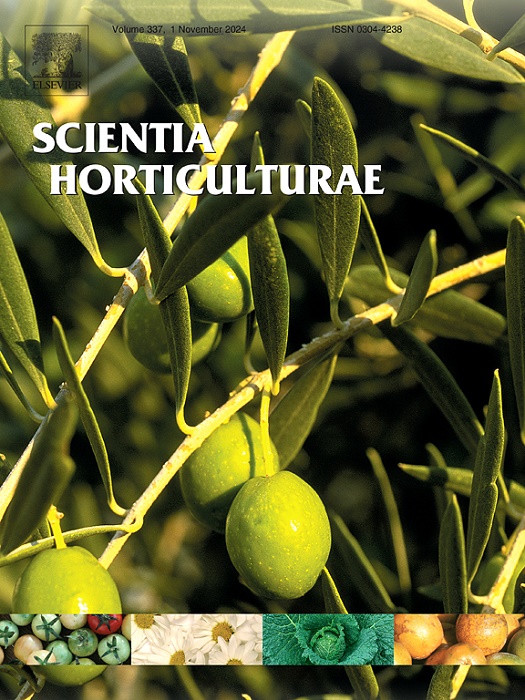利用扫描电子显微镜模拟和分析水肥耦合条件下南瓜叶片的生长-光合-产量关系
IF 3.9
2区 农林科学
Q1 HORTICULTURE
引用次数: 0
摘要
南瓜是中国西北干旱区重要的经济作物。其产量与叶片生长和光合特性密切相关,受水肥耦合的营养调节。通过两年的田间试验,分析了水肥耦合条件下叶片生长、光合特性与产量的关系。结果表明:叶片面积指数(LAI)、土壤与植物分析发育值(SPAD)、净光合速率(Pn)、蒸腾速率(Tr)、气孔导度(Gs)和产量均随灌溉定额的增加而增加,随有机肥施用量的增加呈现先增加后降低的趋势;F2W3处理(灌溉定额为525 m3·ha−1,总施肥量为5700kg·ha−1)LAI、SPAD、Pn、Tr、Gs和产量最高。水肥耦合对产量、SPAD和Gs(P <)有极显著影响;0.01),成熟期LAI和开花期Tr影响显著(P <;0.05)。基于结构方程模型(SEM)分析表明,合理的水肥耦合可以调节南瓜叶片LAI和SPAD,进而改善其光合特性,最终提高南瓜产量。分别提取光合特性关键指标Gs和叶片生长指标SPAD,对Yield-SPAD-Gs进行综合评价。结果表明,水肥耦合调节的最佳灌溉定额范围为510.57 ~ 526.9 m3·ha−1,有机肥调节的最佳灌溉定额范围为5698.24 ~ 6465.54 kg·ha−1。因此,推荐F2W3处理为该地区南瓜栽培的最佳处理。本文章由计算机程序翻译,如有差异,请以英文原文为准。

Simulation and analysis of pumpkin leaf growth-photosynthesis-yield relationship under water‐fertilizer coupling by SEM
Pumpkin is an important cash crop in the northwestern arid region of China. Its yield is closely related to leaf growth and photosynthetic characteristics, which are nutritionally regulated by water-fertilizer coupling. Through a two year field experiment, the relationship between leaf growth, photosynthetic characteristics and yield under water-fertilizer coupling was analyzed. The results showed that leaf area index (LAI), soil and plant analyzer development value (SPAD), net photosynthetic rate (Pn), transpiration rate (Tr), stomatal conductance (Gs) and yield all increased with increasing irrigation quota, and showed an increasing and then decreasing trend with increasing organic fertilizer application amount. Under F2W3 treatment (irrigation quota of 525 m3·ha−1 and total fertilization application of 5700kg·ha−1), LAI, SPAD, Pn, Tr, Gs and yield were all the highest. Water-fertilizer coupling had highly significant effects on yield, SPAD and Gs(P < 0.01), significant effects on LAI at maturity stage and Tr at flowering stage (P < 0.05). Based on structural equation modeling (SEM), it was shown that a reasonable water-fertilizer coupling could regulate LAI and SPAD of pumpkin leaves, and then improve their photosynthetic characteristics, and ultimately increase pumpkin yield. Gs (as the key index of photosynthetic characteristics) and SPAD (as that of leaf growth) were extracted separately for a comprehensive evaluation of Yield-SPAD-Gs. It was found that the range of optimal irrigation quota regulated by water-fertilizer coupling was 510.57 ∼ 526.9 m3·ha−1, and that of optimal organic fertilizer application was 5698.24 ∼ 6465.54 kg·ha−1. Therefore, F2W3 treatment was recommended as the optimal treatment for pumpkin cultivation in the region.
求助全文
通过发布文献求助,成功后即可免费获取论文全文。
去求助
来源期刊

Scientia Horticulturae
农林科学-园艺
CiteScore
8.60
自引率
4.70%
发文量
796
审稿时长
47 days
期刊介绍:
Scientia Horticulturae is an international journal publishing research related to horticultural crops. Articles in the journal deal with open or protected production of vegetables, fruits, edible fungi and ornamentals under temperate, subtropical and tropical conditions. Papers in related areas (biochemistry, micropropagation, soil science, plant breeding, plant physiology, phytopathology, etc.) are considered, if they contain information of direct significance to horticulture. Papers on the technical aspects of horticulture (engineering, crop processing, storage, transport etc.) are accepted for publication only if they relate directly to the living product. In the case of plantation crops, those yielding a product that may be used fresh (e.g. tropical vegetables, citrus, bananas, and other fruits) will be considered, while those papers describing the processing of the product (e.g. rubber, tobacco, and quinine) will not. The scope of the journal includes all horticultural crops but does not include speciality crops such as, medicinal crops or forestry crops, such as bamboo. Basic molecular studies without any direct application in horticulture will not be considered for this journal.
 求助内容:
求助内容: 应助结果提醒方式:
应助结果提醒方式:


